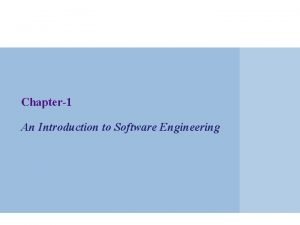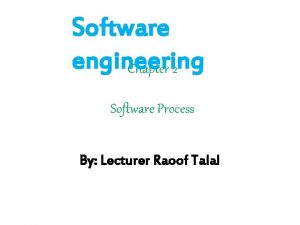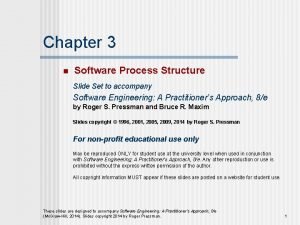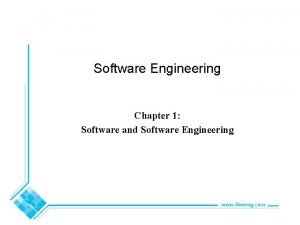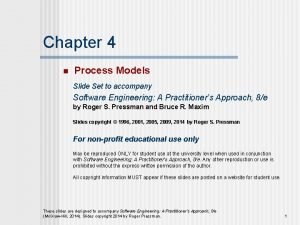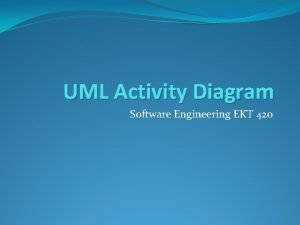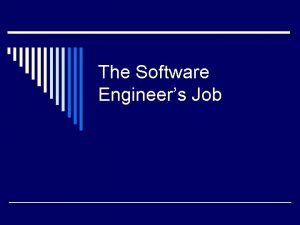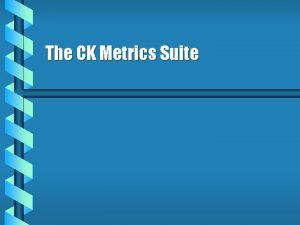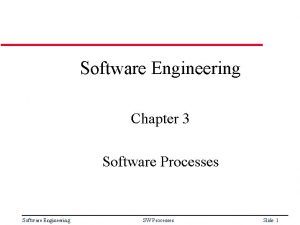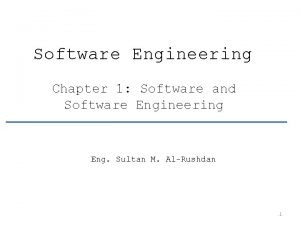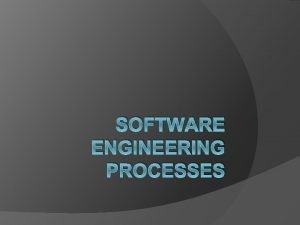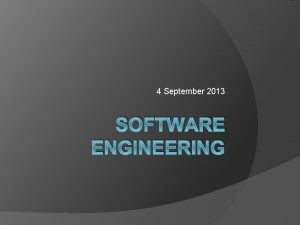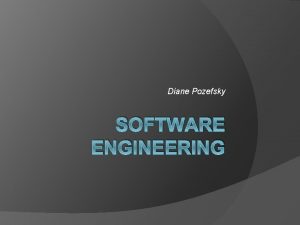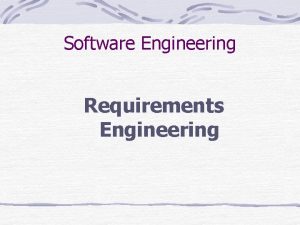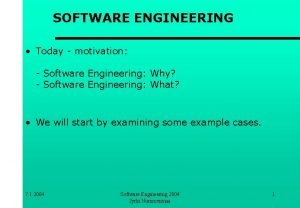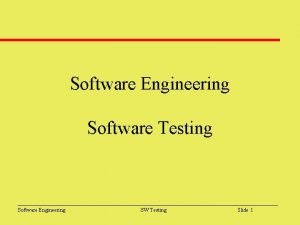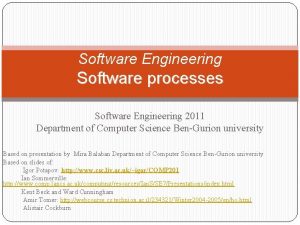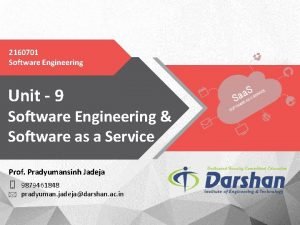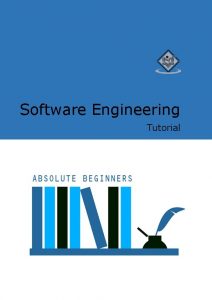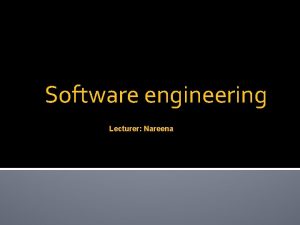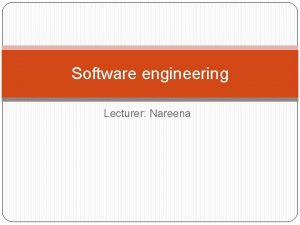Chapter 1 Introduction to Software Engineering 1 Introduction
























- Slides: 24

Chapter 1 - Introduction to Software Engineering 1

Introduction Read chapter thoroughly Key points Exercises. . . We will Read project Deliverables and tentative lecture schedule Read syllabus. . Form teams Importance of class attendance; team participation; short quizzes. Key: don't get behind. . . History of Software Engineering p 5 Software crisis Large complex systems - no scaling Cost overruns, requirements not met, over budget, late Let's start off with the basics: 2

Frequently Asked Questions about Software Engineering Question Answer What is software? Computer programs and associated documentation. Software products may be developed for a particular customer or may be developed for a general market. What are the attributes of good software? Good software should deliver the required functionality and performance to the user and should be maintainable, dependable and usable. What is software engineering? Software engineering is an engineering discipline that is concerned with all aspects of software production. What are the fundamental engineering activities? software Software specification, software development, software validation and software evolution. What is the difference between software Computer science focuses on theory and fundamentals; engineering and computer science? software engineering is concerned with the practicalities of developing and delivering useful software. What is the difference between software System engineering is concerned with all aspects of engineering and system engineering? computer-based systems development including hardware, software and process engineering. Software engineering is part of this more general process. 3 Chapter 1 Introduction 2

Frequently Asked Questions about Software Engineering Question Answer What are the key challenges software engineering? What are the engineering? costs of facing Coping with increasing diversity, demands for reduced delivery times and developing trustworthy software Roughly 60% of software costs are development costs, 40% are testing costs. For custom software, evolution costs often exceed development costs. What are the best software engineering While all software projects have to be professionally techniques and methods? managed and developed, different techniques are appropriate for different types of system. For example, games should always be developed using a series of prototypes whereas safety critical control systems require a complete and analyzable specification to be developed. You can’t, therefore, say that one method is better than another. What differences has the web made to The web has led to the availability of software services and software engineering? the possibility of developing highly distributed servicebased systems. Web-based systems development has led to important advances in programming languages 4 and 3 Chapter 1 Introduction software reuse.

Essential Attributes of Good Software Often referred to as "Quality Metrics" Sometimes called "Non-Functional Requirements" Product characteristic Description Maintainability Software should be written in such a way so that it can evolve to meet the changing needs of customers. This is a critical attribute because software change is an inevitable requirement of a changing business environment. Dependability and security Software dependability includes a range of characteristics including reliability, security and safety. Dependable software should not cause physical or economic damage in the event of system failure. Malicious users should not be able to access or damage the system. Efficiency Software should not make wasteful use of system resources such as memory and processor cycles. Efficiency therefore includes responsiveness, processing time, memory utilisation, etc. Acceptability Software must be acceptable to the type of users for which it is designed. This means that it must be understandable, usable and compatible with other systems that they use. 5 Chapter 1 Introduction 4

Essential Attributes of Good Software Often referred to as "Quality Metrics" Sometimes called "Non-Functional Requirements" • • More: Many other quality metrics such as Reliability Scalability Portability Reusability Useability 6

Software Engineering • • Software engineering is an engineering discipline that is concerned with all aspects of software production from the early stages of system specification through to maintaining the system after it has gone into use. Engineering discipline • Using appropriate theories and methods to solve problems bearing in mind organizational and financial constraints. • All aspects of software production • Not just technical process of development. Also project management and the development of tools, methods etc. to support software production. Chapter 1 Introduction 77

Software Process Activities (High level view) • • Software specifications, where customers and engineers define the software that is to be produced and the constraints on its operation. Software development, where the software is designed and programmed. Software validation, where the software is checked to ensure that it is what the customer requires. Software evolution, where the software is modified to reflect changing customer and market requirements. Chapter 1 Introduction 68

Software Engineering Diversity • There are many different types of software system and there is no universal set of software techniques that is applicable to all of these. • The software engineering methods and tools used depend on the type of application being developed, the requirements of the customer and the background of the development team. • Many companies do not subscribe exactly to any specific process. Rather, they use a hybrid of activities that ‘fits’ their organization, tools, experience, and frankly what ‘works for them. ’ Chapter 1 Introduction 79

Key examples of diverse systems Stand alone apps Interactive transaction-based apps Embedded real time systems Process control systems Batch systems Data collection systems. And more. . . 10

Software Engineering Fundamentals • Some fundamental principles apply to all types of software system • Systems should be developed using a managed and understood development process. • Dependability and performance are important for all systems. But there are many other quality metrics needed!! • Understanding and managing the software specification and requirements (what the software should do) are vitally important. • Where appropriate, you should reuse software that has already been developed rather than write new software. Chapter 1 Introduction 11 8

Software Engineering and the Web • The Web is now a platform for running application and organizations are increasingly developing web-based systems rather than local systems. • Web services allow application functionality to be accessed globally • We must consider our developments global by default. • Cloud computing is an approach to the provision of computer services where applications run remotely on the ‘cloud’. • Users do not buy software buy pay according to use. Chapter 1 Introduction 12 9

Web Software Engineering • Software reuse is the dominant approach for constructing web-based systems. • When building these systems, you think about how you can assemble them from pre-existing software components and systems. • Web-based systems should be developed and delivered iteratively and incrementally. • It is now generally recognized that it is impractical to specify all the requirements for such systems in advance. • User interfaces are constrained by the capabilities of web browsers. • Technologies such as AJAX allow rich interfaces to be created within a web browser but are still difficult to use. • Web forms with local scripting are more commonly used. Chapter 1 Introduction 13 10

Software Engineering Ethics • • Software engineering involves wider responsibilities than simply the application of technical skills. This is dramatically different than software development. years ago. • Software engineers must behave in an honest and ethically responsible way if they are to be respected as professionals. • Ethical behavior is more than simply upholding the law but involves following a set of principles that are morally correct. 14

Issues of Professional Responsibility • Confidentiality • Engineers should normally respect the confidentiality of their employers or clients irrespective of whether or not a formal confidentiality agreement has been signed. • When being fired, often employee is not allowed to return to his/her desk! • Competence • Engineers should not misrepresent their level of competence. They should not knowingly accept work which is out with their competence. • Intellectual property rights • Engineers should be aware of local laws governing the use of intellectual property such as patents, copyright, etc. They should be careful to ensure that the intellectual property of employers and clients is protected. • Computer misuse • Software engineers should not use their technical skills to misuse other people’s computers. Computer misuse ranges from relatively trivial (game playing on an employer’s machine, say) to extremely serious (dissemination of viruses). 15

ACM/IEEE Code of Ethics • • • The professional societies in the US have cooperated to produce a code of ethical practice. We have these posted along our inner hallways. Members of these organizations sign up to the code of practice when they join. Absolutely you need to belong to the ACM, IEEE CS and perhaps a couple of others in your area of specialization. The Code contains eight Principles related to the behavior of and decisions made by professional software engineers, including practitioners, educators, managers, supervisors and policy makers, as well as trainees and students of the profession. 16

The ACM/IEEE Code of Ethics Software Engineering Code of Ethics and Professional Practice ACM/IEEE-CS Joint Task Force on Software Engineering Ethics and Professional Practices PREAMBLE The short version of the code summarizes aspirations at a high level of the abstraction; the clauses that are included in the full version give examples and details of how these aspirations change the way we act as software engineering professionals. Without the aspirations, the details can become legalistic and tedious; without the details, the aspirations can become high sounding but empty; together, the aspirations and the details form a cohesive code. Software engineers shall commit themselves to making the analysis, specification, design, development, testing and maintenance of software a beneficial and respected profession. In accordance with their commitment to the health, safety and welfare of the public, software engineers shall adhere to the following Eight Principles: Chapter 1 Introduction 17 14

Ethical Principles 1. PUBLIC - Software engineers shall act consistently with the public interest. 2. CLIENT AND EMPLOYER - Software engineers shall act in a manner that is in the best interests of their client and employer consistent with the public interest. 3. PRODUCT - Software engineers shall ensure that their products and related modifications meet the highest professional standards possible. 4. JUDGMENT - Software engineers shall maintain integrity and independence in their professional judgment. 5. MANAGEMENT - Software engineering managers and leaders shall subscribe to and promote an ethical approach to the management of software development and maintenance. 6. PROFESSION - Software engineers shall advance the integrity and reputation of the profession consistent with the public interest. 7. COLLEAGUES - Software engineers shall be fair to and supportive of their colleagues. 8. SELF - Software engineers shall participate in lifelong learning regarding the practice of their profession and shall promote an ethical approach to the practice of the profession. Chapter 1 Introduction 18 15

Ethical Dilemmas • Disagreement in principle with the policies of senior management. Discuss • Your employer acts in an unethical way and releases a safety-critical system without finishing the testing of the system. Discuss • Participation in the development of military weapons systems or nuclear systems. Discuss 19

Here in the following slides are some introductory thoughts regarding architecture. We will be taking through many of these in future lectures. But for now. . . 20

Case study – An Insulin Pump Control System • A personal insulin pump • An embedded system in an insulin pump used by diabetics to maintain blood glucose control. • Insulin pump control system • Collects data from a blood sugar sensor and calculates the amount of insulin required to be injected. • Calculation based on the rate of change of blood sugar levels. • Sends signals to a micro-pump to deliver the correct dose of insulin. • Safety-critical system as low blood sugars can lead to brain malfunctioning, coma and death; high-blood sugar levels have longterm consequences such as eye and kidney damage. Chapter 1 Introduction 21 17

Insulin pump hardware architecture Chapter 1 Introduction 22 22

Activity model of the insulin pump Chapter 1 Introduction 23 19

Essential high-level requirements (sometimes called User Stories or Features) The system shall be available to deliver insulin when required. The system shall perform reliably and deliver the correct amount of insulin to counteract the current level of blood sugar. The system must therefore be designed and implemented to ensure that the system always meets these requirements. These (above) came from the book, but clearly they are way to high level to provide any real direction to development. We will discuss mechanisms to capture functional and nonfunctional requirements in lectures coming up. Chapter 1 Introduction 24 20
 System architecture example
System architecture example Forward engineering and reverse engineering
Forward engineering and reverse engineering Software maintenance process models ppt
Software maintenance process models ppt Who invented software engineering
Who invented software engineering What is software metrics in software engineering
What is software metrics in software engineering Example of software crisis
Example of software crisis Software metrics example
Software metrics example Real time software design in software engineering
Real time software design in software engineering Software design fundamentals in software engineering
Software design fundamentals in software engineering Changing nature of software engineering
Changing nature of software engineering Introduction to software engineering course outline
Introduction to software engineering course outline Software engineering chapter 2
Software engineering chapter 2 Software engineering pressman chapter 3 ppt
Software engineering pressman chapter 3 ppt Nature of software engineering
Nature of software engineering Software engineering pressman chapter 4 ppt
Software engineering pressman chapter 4 ppt Principles of complex systems for systems engineering
Principles of complex systems for systems engineering Elegant systems
Elegant systems Reverse engineering vs forward engineering
Reverse engineering vs forward engineering Virtual labs iit kharagpur
Virtual labs iit kharagpur User interface design steps in software engineering
User interface design steps in software engineering Srs tools in software engineering
Srs tools in software engineering Activity diagram software engineering
Activity diagram software engineering Software engineering task
Software engineering task Draw and describe management spectrum
Draw and describe management spectrum Ck metrics
Ck metrics









